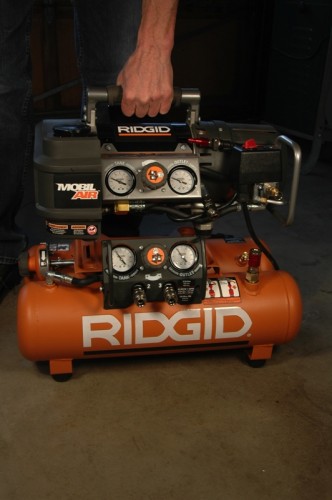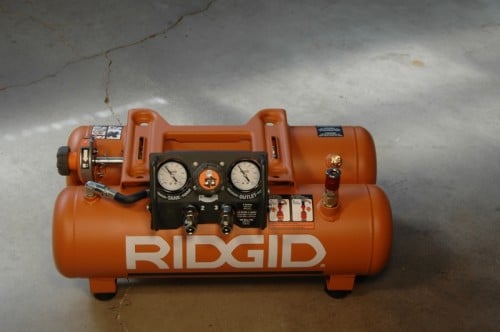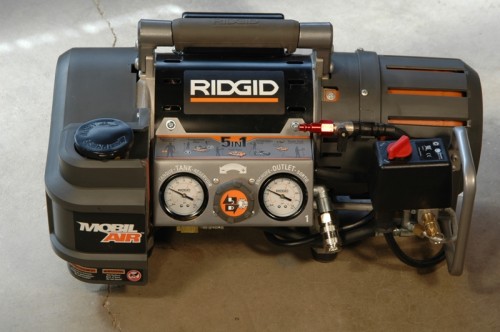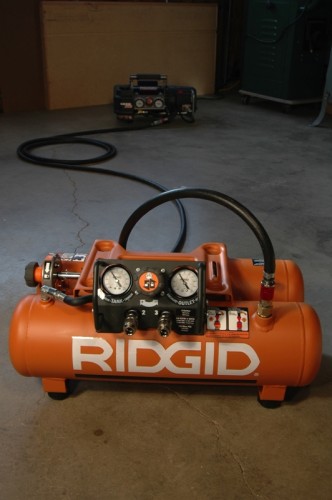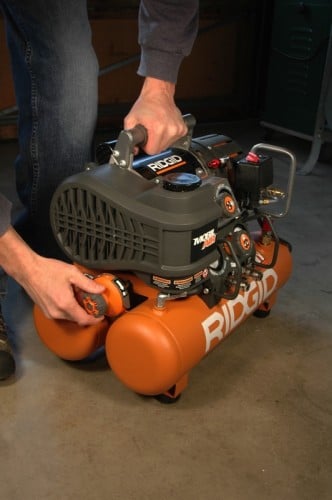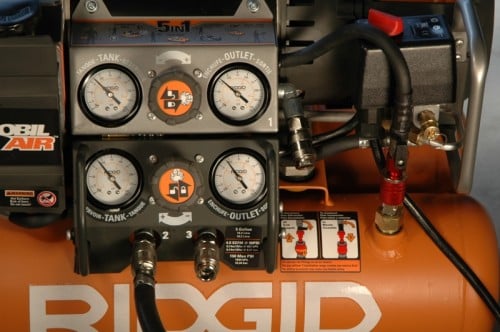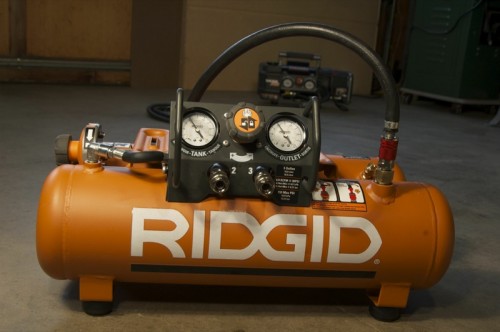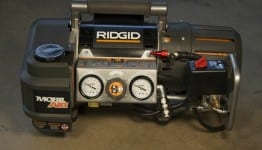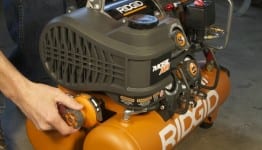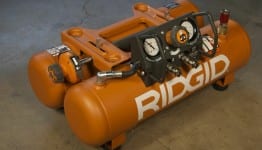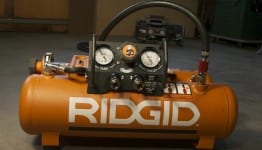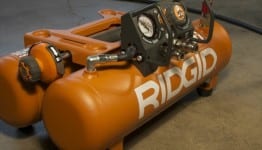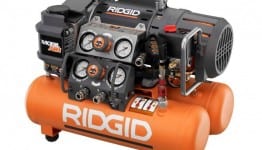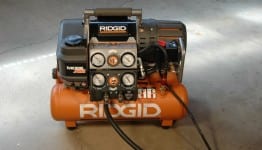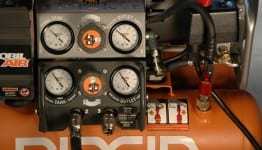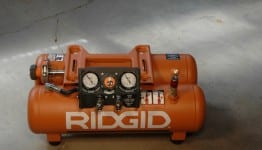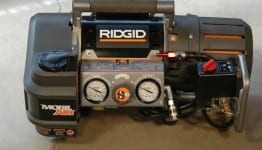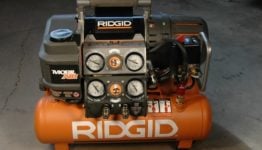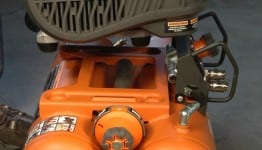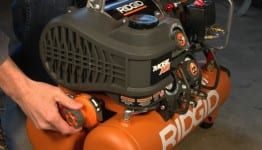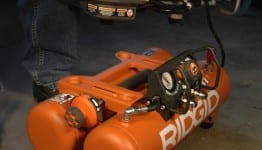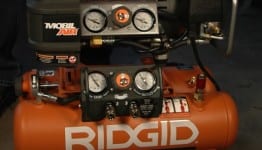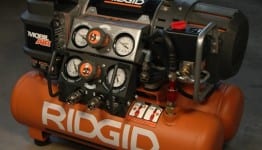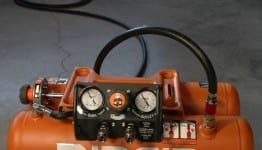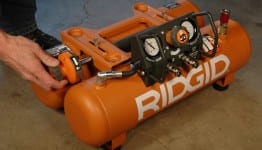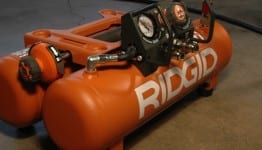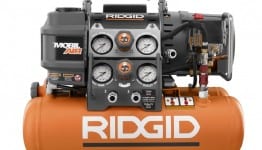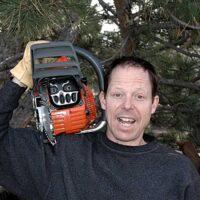The Ridgid Tri-Stack air compressor is a star performer in the brand’s line of inventive compressor designs. At first glance, it’s a 150 psi, five gallon compressor that is a capable size for most job site tasks. But a closer look reveals a much more versatile tool with features and abilities not found on other compressors in its class.
[pullquote]A five gallon workhorse that’s like three tools in one[/pullquote]
The Ridgid Tri-Stack Air Compressor breaks down into two components: the motor section and the tank section. Besides allowing the user to carry the 77-pound weight of the compressor split between both hands, this convertible function provides flexible uses of the tool on the job as well. When disassembled, the Tri-Stack provides separate mini-compressor and storage tank units—each with its own regulator and air outlets. The motor section also has its own small tank, so it can be used alone for small jobs like trim work to keep you from having to lug the weight of the complete five gallon unit around when it’s not needed. In addition, the tank section can be hauled out for mobile punch lists or more remote tasks like tire inflation.
Taking the Top Down
The convertible function of the Ridgid Tri-Stack Air Compressor is what makes it really different than other five gallon air compressors. To separate the two sections, you just need to disconnect the air hose between them and mechanically de-couple their locking connection. The air hose has a small ball valve that you must close before disconnecting to keep the motor section’s small tank from rapidly exhausting its air. At the physical connection point, the rubber feet of the motor section fit into divots formed into the welded bridge that connects the two main air tanks below. Once in place, twisting a spring-loaded locking knob rotates two steel hooks up out of their storage positions to mechanically lock the motor and tank sections together. The hooks are beefy, and the knob mechanism is sound, so the locking assembly never gave me any cause for concern about the two halves accidentally separating. I did, however, test the durability of the short connecting hose many times…by unlocking the two sections and then yanking up on the motor unit. Forgetting to disconnect the air hose so many times allows me to report that it passed my unintended and repeated torture tests with no apparent ill effects.
Comfortable rubber-grip handles are located at the balance point of both sections, and there is a right way and a wrong way to situate the tool in all three configurations so that gauges, knobs, and couplings don’t dig into your legs while carrying.
Tank Section
Besides being able to top off four underinflated car tires on one charge, the tank section by itself has a few valid uses on the job site too. In nailing tests, the 4-1/2 gallons of air stored in the tanks could shoot about forty-five three-inch framing nails or about eighty-five 2-inch trim nails into stacked 2x material. That’s enough nailing for a handful of punch list tasks or installing all of the baseboard in a room. It’s lighter (and quieter, of course) than the motor unit, so for small jobs—or in a location without power—it may be the most convenient half to grab.
Ridgid Tri-Stack Air Compressor Motor Section
The motor section has a 1/2-gallon tank, so it can be used as a self-contained mini-compressor. The tiny storage volume means that the motor cycles nearly constantly, though. I could only shoot one to two framing nails or two to three trim nails before the pressure dropped enough to require the tank to be pumped up again. Since the motor and pump are sized for a five gallon compressor, they are more than enough to quickly fill the 1/2-gallon tank, but the constant off/on cycling is annoying, and the lack of reserve air will slow you down during framing and roofing uses. Hot air is much less dense at a given pressure than air at room temperature, so with the 1/2-gallon tank being filled constantly, its small volume of hot air is even smaller. I also worry that running the compressor nearly continuously like this for an extended period may overheat the motor, pump, or wiring. For most uses, keeping the air tanks linked is the way to get the best performance out of the Tri-Stack.
Remote Motor Use
Keeping the air tanks linked doesn’t mean that the motor and tank sections have to be kept in their stacked configuration, however. Since the air tanks of the two sections are linked by a short length of air hose when stacked, separating them physically just means that a longer hose needs to be used—the Tri-Stack will still perform as a full-capacity five-gallon compressor.
Since the tank section of the Ridgid Tri-Stack Air Compressor has its own regulator and two air outlets onboard, the motor section doesn’t need to be near the work space and can be positioned quite a distance away. This allows the noise and heat of the motor section to be kept in a different room or even outdoors. Of course you can leave any compressor across the building from your work location and just run a long hose, but being near your pressure regulator is crucial for setting the pressure accurately and when switching between different tools and tasks.
[pullquote]Being near your pressure regulator is crucial for setting the pressure accurately and when switching tools, so having a two-piece compressor is preferred to just using a long hose with a standard compressor.[/pullquote]
Unlike the scream of compressors and other tools with high-speed universal (brushed) motors, the large induction motor on the Tri-Stack generates a less annoying sound. I would describe it as a loud but pleasant baritone buzz that is not unbearable, but that probably delivers enough sound pressure to cause hearing damage (over time) just the same. I didn’t perform a decibel reading on this compressor, but it’s obvious to my common-sense-powered dosimeter that it necessitates either hearing protection, or being relegated to another room.
Two Compressors in One
With each section having its own storage tank and regulator, the Tri-Stack could be used by two workers simultaneously if you needed to get work done in two distant rooms or at two different air pressures. However, any use of the motor section air outlet—whether the two sections are linked or not—comes with the same limitations mentioned above. Being connected to the main tanks does not give the small motor section tank access to any additional storage volume, nor does it provide a faster refill time. In fact, the capacity and pressure of the 1/2 gallon tank will fluctuate at the whim of the main tank user downstream. Since there is a one-way valve between the tanks, the main tanks drain down the pressure in the motor tank at the same rate they are draining, but the air contained in the main tanks isn’t able to refill the smaller tank.
Since any use of the main tanks will affect the pressure of the other, simultaneous use could cause the output of the small tank to drop below where you set its regulator and provide uneven output pressures—even while the pump is running. Also, the small tank alone triggers the pump cycling, and using it for just about anything will require nearly constant cycling. For these practical reasons, I recommend using the small tank air outlet of the Tri-Stack only as a last resort.
Basic Features
Pressure regulator adjustments are made just like any other compressor. You pull out the knob, turn it clockwise or counterclockwise to adjust the pressure, and push it back in to lock. But the size, shape and texture of the knobs are much better than most. Instead of common straight-sided, slippery plastic knobs, the Tri-Stack features generously-sized knobs with bulbous rubber ends that make it easier to dial in your desired pressure while wearing even the thickest work gloves. This is a nice professional touch that users will notice and appreciate whether they are wearing gloves or not.
Air hose outlet couplings on the Tri-Stack are the push-in type that don’t require pulling back on a spring-loaded metal sleeve to insert a hose plug. This simplifies plugging in an air hose and qualifies them as one-handed couplings because, even though you must pull the sleeve when releasing a hose, it can be done easily enough with one hand. That being said, when using either section separately, the amount of force required to push the hose plug into the outlet will slide the unit back across the floor if it’s set on a dusty or otherwise slippery surface. In this case it may require a second hand to anchor the unit. In the rare instances when I have not had a free hand, quickly shoving the plug usually clicked it in without moving the compressor section very far.
There are actually four female coupling fittings on the Tri-Stack but only three of them are for use as air outlets. The fourth is used as the filler inlet to the tank section and a one-way valve located between it and the tank keeps it from expelling any air if you accidentally connect a hose to it. This is a nice safety feature because the unregulated air pressure in the tanks could potentially damage the seals or drivers in a tool and cause an unsafe nailing situation at 150 psi. One thing we did note is that the inlet valve on the tanks is situated directly on top—and it’s completely uncovered. As a result, any sawdust or debris encountered during your work day could potentially make it inside and subsequently get blown into the tank the next time you connect the motor unit’s supply hose. We’ll probably rig some kind of inlet condom to cover the connector, but we would have loved to see some kind of cap integrated into the unit to better protect the tank.
The outlet couplings fit both 1/4-inch industrial and automotive plug profiles (also known as Type M and Tru Flate plugs, respectively). Between these two common fitting types, the Tri-Stack should be ready to go for both nailers in the field or impact driving tools used more commonly in the shop.
Unit stability rates very-good to excellent for the Tri-Stack. Whether fully assembled or broken down into separate sections, all components of this compressor have been designed to stay low and stable on their grippy rubber feet. The units carry well, sit flat, and are unlikely to tip over in the back of a truck. If they do take a tumble, roll cage features protect the gauges, knob and air outlet of the motor section, but fall just short of shielding the air outlets from impact on the tank section.
Another important, yet often overlooked aspect of unit stability is the measure of how well a compressor stays put while it’s pumping up. I have used lightweight units that skittered across a dusty floor the instant the motor started and would pull out their own cord within several seconds. I’m glad to report that the Tri-Stack always stayed put, no matter what kind of surface it was sitting on.
Draining the air tanks is made easier by having quarter-turn ball valves located at the bottom of all three tanks. The small plastic lever tabs on each valve provide a wide, flat area to twist that won’t hurt your fingertips like the thin metal tabs on some drain valve assemblies. With only 5/8-inch of ground clearance, I was concerned that the plastic tabs on the twin 2-1/2 gallon tanks would be susceptible to damage, but so far I have not experienced any mishaps. Pickup trucks with deeply-ribbed plastic bedliners may present a problem, so my advice is to check that the 77 pounds of the Tri-Stack is not sitting on the valve lever or even the valve itself when transporting.
The motor overload circuit button is located low on the back of the motor, and it got a lot of use at times. I quickly learned that even though the compressor motor is rated at 14.5 amps, the high start-up draw makes the Tri-Stack difficult to use on 15 amp circuits. With a 50 foot long, 12-gauge cord attached to an outlet on a 15 amp breaker, the motor would only start if I drained the tank way down to reduce the load on the pump significantly. Usually, the motor would strain to start and then kick its overload circuit after a few wheezy chugs of the pump. I checked the voltage drop at the compressor plug, and at start-up it plummeted from 124 volts down to 76 volts—way too low. After plugging directly into the outlet, the voltage dropped as low as 82 volts, but at least the compressor motor would start without much hesitation. The product manager said that the Tri-Stack should start down to 100 volts, but I found it could beat that spec in tough circumstances. Of course that’s no way to treat a motor you want to keep in good repair, so I suggest finding a 20 amp circuit and avoiding the use of an extension cord whenever possible. (And if you do need to run one, make sure it’s a 10 gauge cord or lower.) As with any compressor, it is much more efficient to run longer air hoses instead of power cords.
An easily removable air filter located atop the unit makes it a breeze to replace, or you can just pop it out and brush or blow it clean. This is a good maintenance practice to perform at regular intervals and especially at the end of any particularly dusty day. The filter’s pleated paper construction is reinforced with wire mesh, so it shouldn’t crush down and let air get by unless damaged by careless handling.
The break-in procedure is not outlined anywhere in the manual, but the product manager recommends running the unit for 15 minutes continuously with the top tank valve open to wear in all of the seals in the pump before the compressor is placed under any load. This is standard practice for oil-free air compressors, so I was surprised that the manual contained no mention of it. This procedure is designed to make the unit run better throughout its service life. (I was assured that proper break-in instructions would be included in the next revision of the owner’s manual.)
A Second Opinion
While I was testing the Ridgid Tri-Stack compressor, a commercial contractor buddy of mine was making regular reports from the field about his unit that he bought about five weeks before I got one. It turns out that we shared many of the same concerns about certain features and were both impressed by the model’s performance strengths. In addition to what I already covered, he mentioned that the three-year warranty seemed better than what he saw from most competitors. And he couldn’t say enough about how the convertible function of this compressor made it the best choice for him and his line of work. Besides making it much less of a physical chore to load and unload into a tall service truck, the ability to isolate the motor and pump noise is a feature he wouldn’t live without. He works in a lot of hospitals and other occupied commercial buildings, so the ability to stash the chugging motor section way down the hall in a supply closet while having the regulator and air outlet in the room he’s working in is an invaluable feature that gives the Tri-Stack an 8.75 out of 10 in his estimation.
A special thanks to Dawee Dodson of Hard Rock Construction in Fort Collins, CO, whose reporting on his experiences with his Ridgid Tri-Stack compressor in the field added additional perspective that helped round out my tool review.


